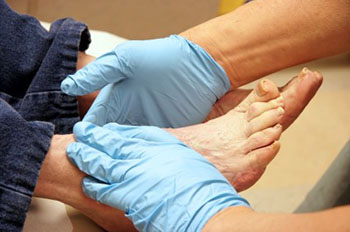
Diabetic Foot Care
Having diabetes increases the risk of developing a wide range of foot problems, often because of two complications of the disease: nerve damage (neuropathy) and poor circulation.
For those with diabetes, small foot problems can turn into serious complications, including:
- ulcers (sores) that don’t heal
- corns
- calluses
- cracked heels
- hammertoes
- bunions
- ingrown toenails
Untreated diabetes can result in other conditions, such as:
Diabetic peripheral neuropathy – this condition doesn’t emerge overnight. Instead, it usually develops slowly and worsens over time. Some patients have this condition long before they are diagnosed with diabetes. Having diabetes for several years may increase the likelihood of having diabetic neuropathy.
Diabetes Foot Care Guidelines
Diabetes can be dangerous to your feet—even a small cut can produce serious consequences. Diabetes may cause nerve damage that takes away the feeling in your feet. Diabetes may also reduce blood flow to the feet, making it harder to heal an injury or resist infection. Because of these problems, you may not notice a foreign object in your shoe. As a result, you could develop a blister or a sore. This could lead to an infection or a nonhealing wound that could put you at risk for an amputation.
To avoid serious foot problems that could result in losing a toe, foot or leg, follow these guidelines.
- Inspect your feet daily. Check for cuts, blisters, redness, swelling or nail problems. Use a magnifying hand mirror to look at the bottom of your feet. Call your doctor if you notice anything.
- Bathe feet in lukewarm, never hot, water. Keep your feet clean by washing them daily. Use only lukewarm water—the temperature you would use on a newborn baby.
- Be gentle when bathing your feet. Wash them using a soft washcloth or sponge. Dry by blotting or patting and carefully dry between the toes.
- Moisturize your feet but not between your toes. Use a moisturizer daily to keep dry skin from itching or cracking. But don’t moisturize between the toes—that could encourage a fungal infection.
- Cut nails carefully. Cut them straight across and file the edges. Don’t cut nails too short, as this could lead to ingrown toenails. If you have concerns about your nails, consult your doctor.
- Never treat corns or calluses yourself. No “bathroom surgery” or medicated pads. Visit your doctor for appropriate treatment.
- Wear clean, dry socks. Change them daily.
- Consider socks made specifically for patients living with diabetes. These socks have extra cushioning, do not have elastic tops, are higher than the ankle and are made from fibers that wick moisture away from the skin.
- Wear socks to bed. If your feet get cold at night, wear socks. Never use a heating pad or a hot water bottle.
- Shake out your shoes and feel the inside before wearing. Remember, your feet may not be able to feel a pebble or other foreign object, so always inspect your shoes before putting them on.
- Keep your feet warm and dry. Don’t let your feet get wet in snow or rain. Wear warm socks and shoes in winter.
- Consider using an antiperspirant on the soles of your feet. This is helpful if you have excessive sweating of the feet.
- Never walk barefoot. Not even at home! Always wear shoes or slippers. You could step on something and get a scratch or cut.
- Take care of your diabetes. Keep your blood sugar levels under control.
- Do not smoke. Smoking restricts blood flow in your feet.
- Get periodic foot exams. Seeing your foot and ankle surgeon on a regular basis can help prevent the foot complications of diabetes.
- It’s time. Your family is your top priority. But if you have diabetes, neglecting your own health could result in serious complications in your feet, leading to amputation or even death. It’s time to pay attention to your diabetes to ensure you can stay at the heart of your family.
“Asian Americans have an elevated risk of being diagnosed with diabetes,” said Priya Parthasarathy, DPM, chair of the APMA Communications Committee and a podiatric physician in practice in Maryland. “Combine that with a tendency to overlook self-care, and Asian women are a population at very high risk for serious complications from diabetes.”
There are simple steps that can help prevent complications of diabetes in your feet:
- It’s time to do a daily foot check. Look for minor injuries and changes to temperature, color, and even hair growth. If you notice a problem, see a podiatrist right away.
- It’s time to stop depending on home remedies. See a podiatrist for proper diagnosis and regular care.
- It’s time to take care at home. Removing your shoes when entering your home is customary, but it puts people with diabetes at significant risk. Wear slippers or other “house shoes” to protect your feet from injury.
- It’s time to cut back on comfort foods. Healthy food is medicine, and small changes can have a big impact for your diabetes. Monitor your blood sugar and see a primary care doctor regularly.
- It’s time to see a podiatrist for regular diabetic foot exams at least once a year.
More information for people with diabetes:
- An Overview: What is diabetes? What is peripheral neuropathy? What is a diabetic foot ulcer?
- How Diabetes Affects Your Health: Watch this short video to learn how diabetes can affect your overall health.
- How Diabetes Affects Your Feet: Check out this video on peripheral neuropathy, or nerve damage in the feet, as a result of diabetes.
- Diabetes Footwear and Products: View our podiatrist-approved products for managing and treating diabetes.
